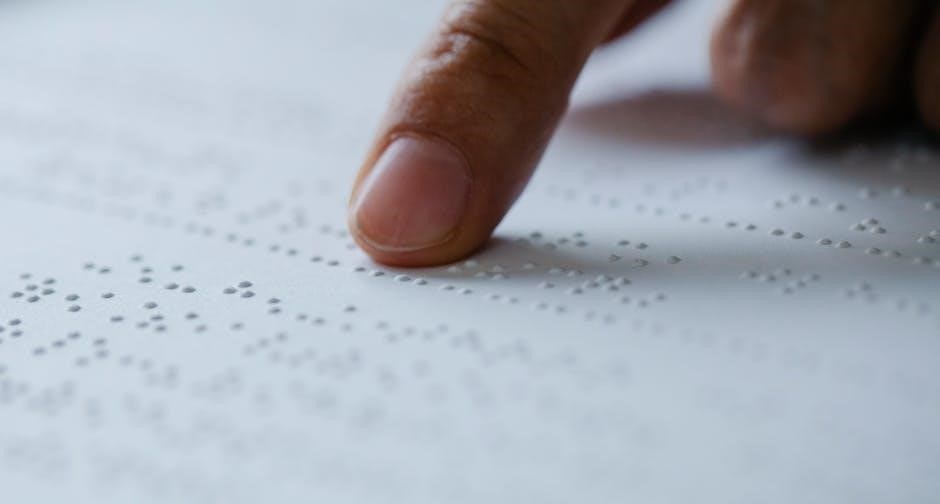The Duxbury Braille Translator (DBT) is a powerful software tool designed to convert text to braille and braille to text, enhancing accessibility for visually impaired individuals. It supports multiple languages and braille codes, offering a user-friendly interface for seamless translation. Widely used by educators, transcribers, and braille readers, DBT empowers communication and learning through its versatile features and customization options, making it an essential resource for braille translation needs.
1.1 Overview of the Duxbury Braille Translator (DBT)
The Duxbury Braille Translator (DBT) is a robust software tool designed to facilitate braille translation, enabling seamless conversion between print and braille formats. It supports multiple languages and braille codes, including Unified English Braille (UEB), making it a versatile solution for diverse needs. DBT offers two primary translation modes: print-to-braille and braille-to-print, catering to both sighted users and braille readers. Its user-friendly interface and customization options ensure high-quality output, making it an indispensable resource for educators, transcribers, and professionals in the field of accessibility.
1.2 Importance of Braille Translation in Accessibility
Braille translation plays a vital role in ensuring accessibility for visually impaired individuals, enabling them to access written information independently. It bridges the communication gap between sighted and blind communities, fostering inclusivity in education, employment, and daily life. High-quality braille materials are essential for literacy and equal opportunities. The Duxbury Braille Translator (DBT) simplifies this process, providing accurate and standardized braille output. By converting text to braille and vice versa, DBT supports the creation of accessible documents, empowering individuals with visual impairments to engage fully in various aspects of society.
1.3 Brief History and Development of DBT
The Duxbury Braille Translator (DBT) was first introduced in the 1970s by Duxbury Systems, Inc., with the goal of providing a reliable tool for braille translation. Over the years, DBT has evolved to support multiple languages and braille codes, becoming a global standard in braille translation. Its development has been driven by the need for accessible communication, with continuous updates to meet the changing needs of users. Today, DBT remains a cornerstone in braille translation, empowering individuals and organizations to produce high-quality braille materials with ease and accuracy.

Installation and Setup of DBT
Installing DBT requires obtaining the software, meeting system requirements, and following step-by-step instructions for setup. Activation and licensing ensure proper functionality, providing a smooth user experience.
2.1 System Requirements for DBT
DBT requires a computer with a 2.0 GHz processor, 4 GB RAM, and 500 MB free disk space. It supports Windows 10/11, macOS 10.15+, and Linux. Ensure your system meets these specifications for optimal performance.
2.2 Step-by-Step Installation Guide
Download the DBT installer from the official website. Run the installer and follow the prompts. Select the installation type (standard or custom). Choose components like translation engines and languages. Select the installation directory and complete the setup. For network installations, refer to the manual for specific instructions. Ensure all prerequisites are met before proceeding. Restart your system if required. Launch DBT to verify successful installation. Consult the user manual for detailed guidance tailored to your system type.
2.3 Activation and Licensing Process
After installation, activate DBT using the license key provided by Duxbury Systems. Open the software and navigate to the “Help” menu, then select “Enter License.” Enter the license key and click “Activate.” For offline activation, generate a request code, submit it to Duxbury Systems, and apply the provided activation code. Ensure internet connectivity for online activation. Refer to the user manual or online tutorials for detailed steps. Proper activation is essential for full functionality. Contact support if issues arise during the licensing process.
Key Features of the Duxbury Braille Translator
The Duxbury Braille Translator offers robust features like print-to-braille and braille-to-print translation, support for multiple languages and braille codes, and customization options for precise braille output, ensuring accessibility and accuracy.

3.1 Translation Modes: Print to Braille and Braille to Print
The Duxbury Braille Translator supports two primary translation modes: print-to-braille and braille-to-print. Print-to-braille mode allows users to input text, which is then accurately translated into braille, while braille-to-print mode converts braille into readable text. These modes are essential for accessibility, enabling seamless communication between visual and tactile formats. Both modes support multiple languages and braille codes, including Unified English Braille (UEB), ensuring versatility for diverse needs. The software’s intuitive interface makes it easy for both newcomers and experienced users to navigate these translation processes efficiently and accurately.
3.2 Support for Multiple Braille Codes and Languages
The Duxbury Braille Translator excels in supporting various braille codes and languages, ensuring global accessibility. It accommodates Unified English Braille (UEB), Grade 1, and other regional codes, making it versatile for diverse needs. Additionally, DBT supports multiple languages, enabling users to translate and produce braille materials in their native tongue. This feature is particularly beneficial for educators, transcribers, and organizations serving multilingual communities, as it eliminates the need for separate tools for different languages or braille systems, streamlining workflows and enhancing productivity.
3.3 Customization Options for Braille Output
The Duxbury Braille Translator offers extensive customization options to tailor braille output according to specific requirements. Users can adjust formatting, margins, page numbers, and line spacing to ensure documents meet precise standards. Additionally, DBT allows for the creation of custom braille styles and templates, enabling consistent formatting across multiple projects. These features are particularly useful for educational institutions and professional transcribers, ensuring braille materials are both accessible and professionally presented. This level of customization enhances the overall quality and readability of braille output, making DBT a versatile tool for diverse needs.
Basic Operations in DBT
DBT simplifies braille translation with intuitive navigation, straightforward manual entry, and efficient file management, ensuring users can easily translate, save, and export braille documents with precision and speed.
4.1 Navigating the DBT Interface
The DBT interface is designed for ease of use, featuring a clear layout with a menu bar, toolbar, and main document area. The menu bar provides access to file operations, translation settings, and help resources. The toolbar offers quick buttons for common tasks like opening files, translating text, and saving documents. The main area displays the text or braille being worked on, with panels for input and output. Users can customize the interface by adjusting settings, such as font sizes and keyboard shortcuts, to optimize their workflow and productivity.
4.2 Manual Entry and Translation Process

Manual entry in DBT allows users to type text directly into the interface for immediate translation. After entering the text, select the desired braille code (e.g., UEB) from the dropdown menu. Click the “Translate” button to convert the text to braille. The translated braille appears in a preview window, enabling users to review and edit before finalizing. This process ensures accurate and efficient translation, catering to both beginners and experienced users. Customization options, such as formatting and special characters, can be adjusted to meet specific needs, enhancing the quality of the braille output.
4.3 Saving and Exporting Braille Files
After translating text to braille, DBT allows users to save the file in various formats, such as .brf or .brl, for later use. To export, navigate to the “File” menu and select “Save As” or “Export.” Choose the desired format and location for the file. This feature ensures that braille documents are easily accessible and can be shared or printed. Additionally, DBT supports exporting to text files, enabling further editing or integration with other accessibility tools. This functionality streamlines workflows for educators, transcribers, and braille readers, enhancing overall efficiency and accessibility.

Input Methods for Braille Translation
DBT offers two primary input methods: print and braille. Print option allows manual text entry, which is then translated into braille. Braille option enables six-key entry for direct braille input, ensuring flexibility for different user needs and preferences.
5.1 Print Option: Manual Entry and Translation
The print option in DBT allows users to manually enter text, which is then translated into braille. This method supports various languages and braille codes, ensuring accurate translation. It is ideal for straightforward conversions and offers customization options for specific formatting needs, making it a versatile tool for braille translation.
5.2 Braille Option: Six-Key Entry System
The braille option in DBT utilizes a six-key entry system, allowing users to input braille directly. This method mimics traditional braille writing, making it intuitive for experienced braille users. The system supports Unified English Braille (UEB) and other codes, ensuring accurate translation. It is particularly useful for transcribing complex braille texts and offers customization options to meet specific formatting needs, enhancing efficiency and precision in braille-to-print translation processes.

Customizing DBT for Specific Needs
DBT allows users to tailor translation settings and create custom braille templates, ensuring output meets specific requirements. This flexibility enhances accuracy and consistency for diverse braille needs.
6.1 Adjusting Translation Settings
DBT offers extensive customization options, allowing users to fine-tune translation settings to meet specific needs. Key adjustments include selecting braille codes, formatting preferences, and language settings. Users can modify punctuation, spacing, and emphasis rules to ensure accurate braille output. The software also supports custom hyphenation and word separation rules. These settings can be saved as profiles for consistent results across projects. By tailoring translation settings, users ensure high-quality, precise braille output tailored to individual or organizational requirements, enhancing accessibility and readability for braille readers.
6.2 Creating and Managing Braille Templates
DBT allows users to create and manage custom braille templates, ensuring consistency across documents. Templates can be tailored to specific needs, such as academic, literary, or technical braille requirements. Users can define settings like margins, page numbers, and formatting rules. These templates can be saved, edited, or deleted as needed, providing flexibility for various projects. Managing templates streamlines workflows, saving time and ensuring uniformity in braille output. This feature is particularly useful for organizations or individuals requiring standardized braille formats for accessibility and readability.

Understanding Braille Translation Specifics
Understanding braille translation specifics involves grasping the rules and nuances of converting text to braille accurately. This ensures clear communication and proper representation of written content effectively.
7.1 Unified English Braille (UEB) Support
The Duxbury Braille Translator (DBT) fully supports Unified English Braille (UEB), the standardized braille code widely adopted in English-speaking countries. UEB ensures consistency in braille translation, addressing previous inconsistencies in literary and technical braille. DBT allows users to select UEB for accurate and uniform braille output, making it easier to produce high-quality materials for visually impaired individuals. This support is crucial for educational and professional settings, ensuring accessibility and clarity in braille communication across various languages and contexts.
7.2 Handling Special Characters and Formatting
The Duxbury Braille Translator (DBT) effectively handles special characters and formatting, ensuring accurate braille representation. It supports various symbols, such as @, $, and &, by converting them into their braille equivalents. DBT also manages formatting elements like bold, italics, and underlining through specific braille indicators. Additionally, it processes page layout features, including headers, footers, and tables, maintaining document structure in braille. This capability ensures that translated materials remain clear and accessible, preserving the original content’s intent and readability for braille users.
Advanced Features of DBT
DBT offers advanced features like batch processing for multiple files and scripting for automated tasks, enhancing efficiency and streamlining workflows for users requiring high-volume braille translations.
8.1 Batch Processing for Multiple Files
DBT’s batch processing feature allows users to translate multiple files simultaneously, saving time and effort. This functionality is ideal for high-volume tasks, enabling the translation of numerous documents in a single operation. By automating the process, users can handle large projects efficiently, ensuring consistent and accurate braille output across all files. This feature is particularly beneficial for professional transcribers and organizations managing extensive braille translation needs, streamlining workflows and enhancing productivity significantly.
8.2 Using Scripts for Automated Tasks
DBT supports scripting, enabling users to automate repetitive tasks such as translation and formatting. By creating custom scripts, users can streamline workflows, saving time and effort. This feature is particularly useful for handling large-scale projects or standardized processes. Scripts can be tailored to specific needs, allowing for precise control over translation settings and output. While scripting requires some technical expertise, it offers advanced users the flexibility to optimize their braille translation processes efficiently, making it a powerful tool for enhancing productivity and consistency in braille production.
Troubleshooting Common Issues
Common issues in DBT include translation errors, formatting problems, or software performance delays. Users can resolve these by checking settings, updating software, or consulting the DBT manual for solutions.

9.1 Resolving Translation Errors
Common translation errors in DBT often stem from incorrect braille code settings or formatting issues. To resolve these, users should first verify that the correct braille code is selected. Next, check for any special characters or formatting that may interfere with translation. If issues persist, consult the DBT manual or online help for troubleshooting guides. Regular software updates can also prevent recurring errors. By following these steps, users can ensure accurate translations and maintain productivity.
9.2 Addressing Software Performance Problems
Performance issues with DBT can often be resolved by ensuring your system meets the software’s requirements. Check for updates to install the latest version, as newer releases often improve stability. Close unnecessary programs to free up memory and processing power. If DBT crashes, restart the application and try again. For persistent issues, clear the cache or temporary files. If problems remain, contact Duxbury Systems support for assistance. Regular maintenance and updates help maintain optimal performance and functionality.

Best Practices for Using DBT
Regularly update DBT to access new features and improvements. Always check system requirements before installation. Use templates for consistent braille output and proofread translations for accuracy.
10.1 Ensuring High-Quality Braille Output
To ensure high-quality braille output, always use the correct braille code, such as Unified English Braille (UEB), and proofread translations for accuracy. Customize settings to match specific needs, like formatting or special characters. Regularly update DBT to access the latest features and improvements. Use templates for consistency and review the braille output before finalizing. Properly handling punctuation, numbers, and emphasis is crucial for readability. By following these steps, you can produce professional-grade braille materials that meet the needs of braille readers.
10.2 Optimizing Workflow for Efficiency
Optimizing workflow in DBT involves automating repetitive tasks and leveraging advanced features. Use batch processing to translate multiple files at once, saving time and effort. Create and manage templates for frequently used documents to maintain consistency. Utilize scripts for automated tasks, such as formatting or converting large volumes of text. Organize files in a structured manner and use keyboard shortcuts to navigate and translate quickly. Regularly review and update settings to align with your workflow needs, ensuring a smooth and efficient translation process.
Case Studies and Real-World Applications
The Cape Town Society for the Blind empowered users with new technology, including updated tools for braille translation. Educational institutions worldwide rely on DBT for creating accessible materials, while professional transcription services utilize it for accurate braille production, demonstrating its real-world impact in promoting accessibility and inclusivity across various sectors.
11.1 Educational Institutions Using DBT
Educational institutions worldwide utilize the Duxbury Braille Translator to create accessible learning materials for visually impaired students. Schools and universities employ DBT to translate textbooks, exam papers, and educational resources into braille, ensuring inclusivity. This tool is particularly valued for its ability to handle complex formatting and multiple languages, making it indispensable for producing high-quality braille materials. By integrating DBT, educational institutions support students’ academic success and promote equal access to knowledge, fostering an inclusive learning environment.
11.2 Professional Braille Transcription Services
Professional braille transcription services rely on the Duxbury Braille Translator to deliver high-quality, accurate braille materials. These services cater to diverse clients, including publishers, governments, and organizations, ensuring accessibility for visually impaired individuals. DBT’s advanced features, such as support for multiple braille codes and languages, enable professionals to handle complex projects efficiently. By streamlining the translation process, DBT helps transcription services meet tight deadlines while maintaining precision, making it an indispensable tool in the industry. This ensures that braille materials are both accessible and of the highest standard.

Resources and Support for DBT Users
DBT users benefit from comprehensive resources, including the official manual, online tutorials, and community forums. These tools provide guidance, troubleshooting, and best practices for effective braille translation.
12.1 Official DBT Manual and Documentation
The official DBT manual is an essential resource for users, providing detailed guidance on installation, features, and troubleshooting. It includes step-by-step instructions, screenshots, and examples to help users master the software. Supplementary materials, such as tutorials and user guides, are also available, ensuring comprehensive support for both beginners and advanced users. These resources are regularly updated to reflect the latest features and best practices, making them indispensable for anyone working with the Duxbury Braille Translator.
12.2 Online Tutorials and Community Forums
Online tutorials and community forums provide valuable support for DBT users. Platforms like YouTube and the Statewide Vision Resource Centre offer video guides, while forums allow users to ask questions and share experiences. These resources help troubleshoot common issues and explore advanced features. Community engagement fosters collaboration, with users sharing tips and best practices. Regular webinars and workshops are also available, ensuring users stay updated on the latest tools and techniques for effective braille translation.
The Duxbury Braille Translator is a vital tool for enhancing accessibility, offering robust features for braille translation. Its future developments promise even greater advancements in assistive technology.
13.1 Summary of Key Takeaways
The Duxbury Braille Translator (DBT) is a powerful tool for converting text to braille and vice versa, ensuring accessibility for visually impaired individuals. It supports multiple languages and braille codes, making it versatile for global use. With a user-friendly interface, DBT simplifies translation processes, catering to educators, transcribers, and braille readers. Its customization options and batch processing enhance efficiency, making it an indispensable resource for braille translation needs.
13.2 Future Developments in Braille Translation Technology
Future advancements in braille translation technology aim to enhance accuracy, speed, and accessibility. AI-driven improvements could automate complex translations, while real-time conversion capabilities may streamline communication. Expanded support for additional languages and braille codes will broaden inclusivity. User-friendly interfaces and integration with assistive devices are expected to further empower individuals. These innovations will ensure braille remains a vital tool for accessibility, fostering independence and opportunities for visually impaired individuals worldwide.